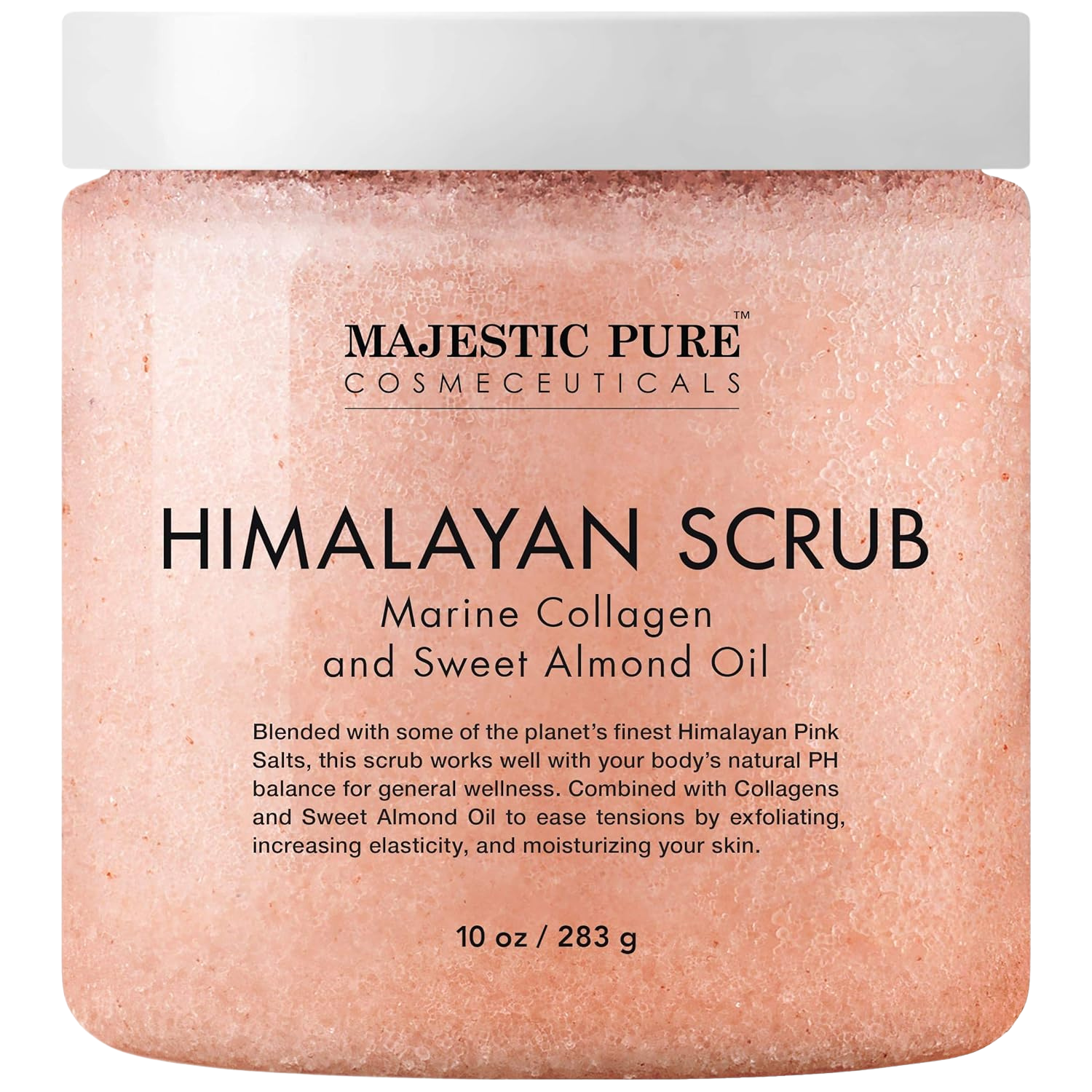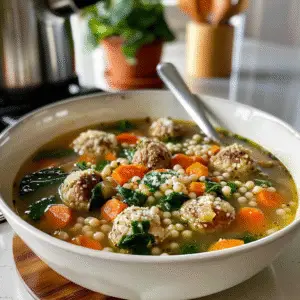Organic gardening is a rewarding journey that connects us to nature. It promotes sustainable gardening practices. For beginners, starting can seem daunting, but with the right tips, it’s easy.
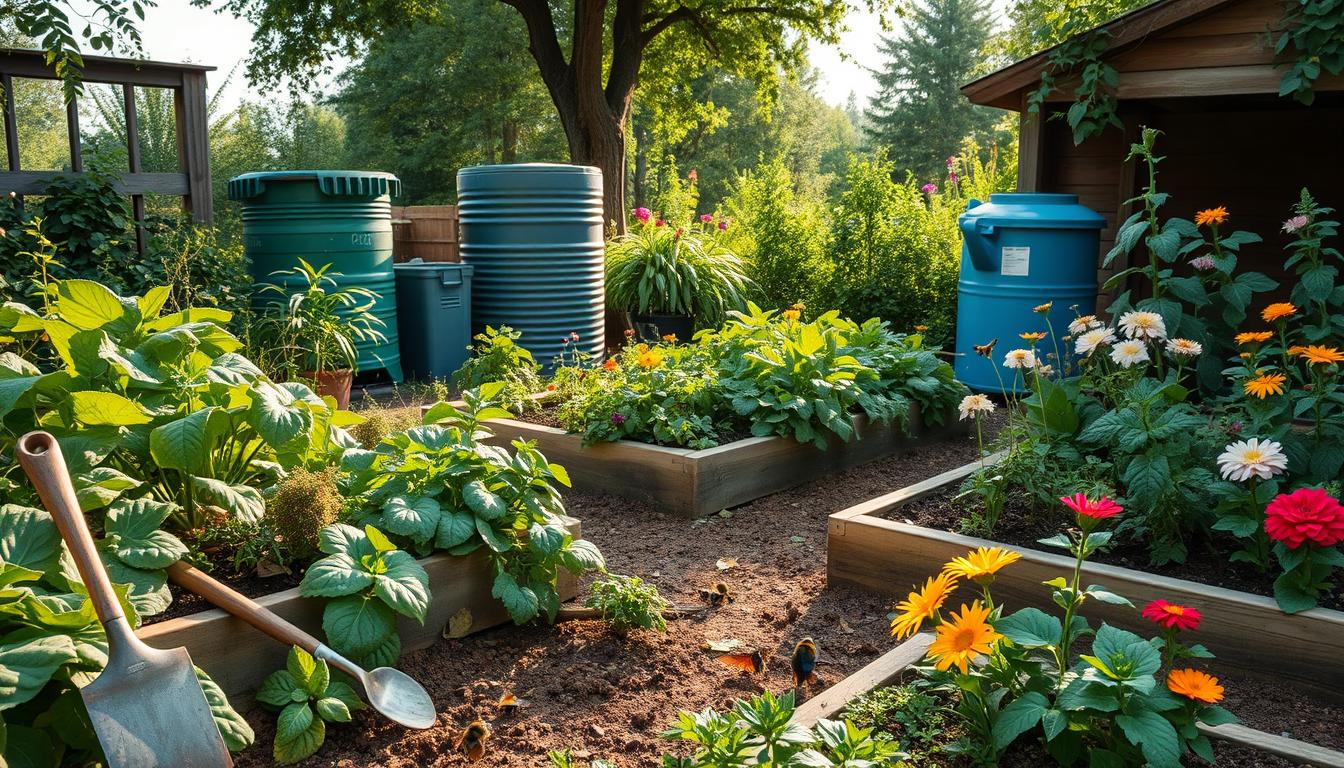
By focusing on soil health, avoiding synthetic fertilizers, and using natural pest control, beginners can create a thriving garden. This garden supports their health and the ecosystem. It also yields nutritious and flavorful produce.
Adopting these practices deepens our connection to the land. It also helps make our planet healthier. This beginner gardening guide provides key strategies for starting your organic gardening journey.
Key Takeaways
- Focus on enriching soil with organic matter like compost for better structure and moisture retention.
- Employ mechanical methods for weed control to prevent deep-rooted weeds while garden maintenance is manageable.
- Utilize companion planting to naturally deter pests and promote beneficial insect populations.
- Practice crop rotation to maintain soil health and minimize the risk of pests and diseases.
- Select organic seeds to ensure high-quality plants that adhere to sustainable practices.
Understanding Organic Gardening
Organic gardening uses natural methods for soil care and pest control. It avoids synthetic chemicals. The organic gardening definition means caring for the whole ecosystem. Gardeners work with plants, insects, and microbes to make their gardens healthy.
The benefits of organic gardening go beyond just growing food. It makes soil better through composting and organic fertilizers. This boosts soil life and helps plants grow. It also saves water with mulching and drip irrigation.
Holistic gardening practices help the ecosystem a lot. Crop rotation keeps pests and diseases away. Using native plants adds to local wildlife and cuts down on work. Gardeners help make a sustainable place for animals and people.
| Aspect | Organic Approach | Conventional Approach |
|---|---|---|
| Fertilization | Uses organic materials like compost and fish emulsion | Employs synthetic fertilizers |
| Pest Control | Relies on natural solutions such as neem oil and companion planting | Uses chemical pesticides |
| Soil Health | Focuses on biodiversity and microbial activity | Often leads to nutrient depletion |
| Water Conservation | Implements mulching and drip irrigation | May result in water runoff due to poor practices |
| Crops | Grown without the use of synthetic chemicals | May contain residues from herbicides and pesticides |
Sustainable Agriculture Basics
Sustainable agriculture is key to organic farming, balancing nature and food production. It supports biodiversity and healthy environments for plants to grow well. Healthy soil is crucial, built through composting and other methods.
Composting adds nutrients and improves soil structure, helping plants grow. Soil tests help gardeners know what their soil needs. This ensures the right amendments are used.
Mulching is vital in organic gardening. It keeps moisture in, fights weeds, and adds organic matter to the soil. Crop rotation and cover crops also protect the soil, preventing nutrient loss and pests.
Choosing organic seeds is important for sustainable farming. Diverse composts offer a wide range of nutrients for plants. Proper planting techniques, like timing and spacing, are also essential for a good harvest.
The National Organic Standard, set in 2002, regulates organic farming in the U.S. It ensures producers follow organic rules. However, finding organic seeds for different crops can be hard.
Many cities offer composting facilities for gardeners. It’s important to add fresh manure 120 days before harvesting. Sewage sludge is not allowed in organic farming.
Organic gardening focuses on preventing pests. It may take more time than conventional methods but is better for the environment. This approach helps protect our planet for the future.
For more health, lifestyle, and gardening tips, consult experts. Always check the terms and limits of information from trusted sources like this link.
Site Selection and Sunlight
Choosing the right spot for your garden is key to success. The location should give plants the best chance to grow. Think about sunlight, water access, and how easy it is to care for your garden.
With these things in mind, you can create a garden that grows well and gives you plenty of fresh produce.
Choosing the Right Location
Look for a spot that gets at least eight hours of direct sunlight a day. Most veggies love full sun and need consistent water to grow well. Shady spots, especially in late morning and afternoon, can slow down plant growth.
It’s also important to know about tree roots. Roots can spread far from the tree trunk, which might harm your veggies.
Identifying Sun Exposure
Sunlight is crucial for a healthy garden. Morning sun helps dry leaves, which fights off fungal diseases. Good air flow around plants also helps prevent diseases.
Be careful not to plant near black walnut trees. They release chemicals that can hurt plant growth. Knowing these things helps beginners pick the best spot for their garden.
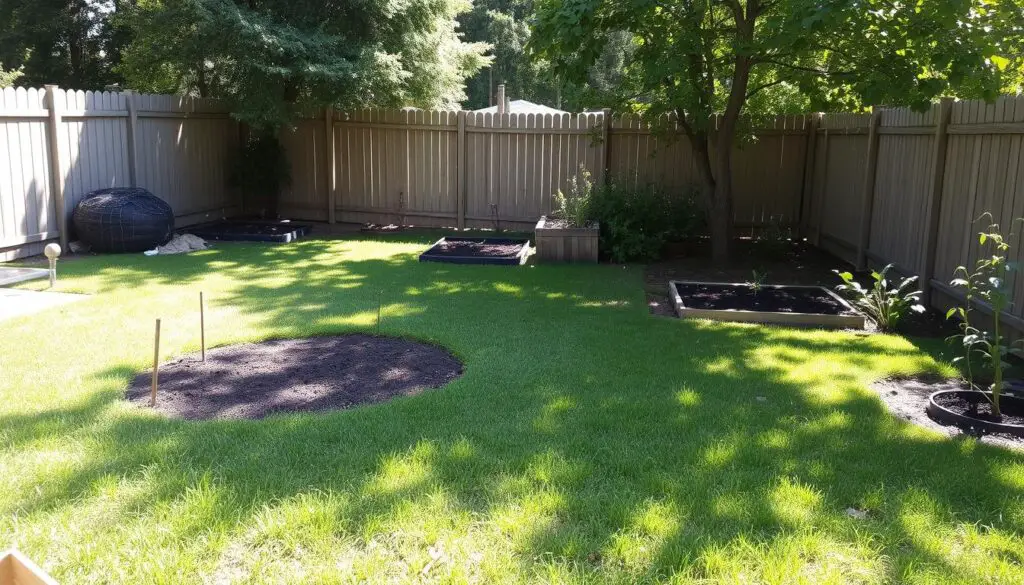
Soil Preparation and Fertility
Healthy soil is key to a successful organic garden. Knowing about soil testing is crucial for improving soil health. It helps create a thriving garden ecosystem.
Testing Your Soil
Soil testing gives you important info on pH levels and nutrients. A balanced pH is essential for plant growth. It also shows if your soil lacks nitrogen, phosphorus, potassium, or calcium.
Regular tests help fix soil issues. This ensures your garden gets the nutrients it needs.
Amending the Soil with Organic Matter
After testing, adding organic amendments is next. Use compost and well-rotted manure to improve soil. They help with structure, water retention, and microbial life.
Start with 1 to 3 inches of organic matter for basic improvements. For deeper beds, add up to 6 to 12 inches. This boosts soil fertility and supports plant health.
Good amendments make soil better for plants. Organic materials increase nutrient availability. This leads to a strong, less prone to erosion garden.
Soil preparation is vital for a successful organic garden. It sets the stage for a thriving garden.
| Components | Benefits |
|---|---|
| Organic Matter | Enhances soil structure and nutrient retention |
| Soil Testing | Identifies nutrient deficiencies and pH levels |
| Mulch | Retains moisture, moderates temperature, and improves structure |
| N-P-K Fertilizers | Resupplies primary nutrients necessary for growth |
Organic Gardening Tips for Pest Control
Effective pest control is key to a successful organic garden. Knowing the common pests helps gardeners use the right strategies. Natural pest management keeps your garden healthy and thriving.
Identifying Common Pests
Many common garden pests can harm your plants. Some of the most common pests are:
- Aphids
- Japanese beetles
- Tomato hornworms
- Flea beetles
It’s important to know which insects are good and which are bad. Some, like ladybugs, help control pests. Keeping your plants healthy helps prevent pests from coming.
Natural Pest Control Methods
Using organic pest control methods is good for the environment. Here are some effective ways:
- Handpicking: Simply removing pests like aphids and tomato hornworms from plants.
- Spinosad: An organic option that works against caterpillars, thrips, beetles, and leaf miners.
- B.T. (Bacillus thuringiensis): Targets insects in their larval stage, reducing pests significantly.
- Diatomaceous earth: Works on hard-shelled insects, a favorite among organic gardeners.
- Neem oil: Repels various garden pests, including flea beetles.
- Pyrethrin: Derived from chrysanthemum flowers, it quickly eliminates insects by disrupting their nervous system.
To better manage pests, clean garden supports and trellises. Use insect netting to keep pests away. Regular garden maintenance, like removing debris in the fall, also helps.
Creating a healthy garden ecosystem naturally controls pests. It may take time, but a thriving garden means fewer pest battles. Start using organic gardening practices to build a sustainable relationship with your plants.
| Pest | Control Method | Effectiveness |
|---|---|---|
| Aphids | Handpicking, Neem oil | High |
| Japanese Beetles | Diatomaceous earth, Pyrethrin | Moderate |
| Tomato Hornworms | B.T., Handpicking | High |
| Flea Beetles | Neem oil, covers | High |
Composting Techniques for a Healthy Garden
Composting is key to organic gardening. It makes soil healthier and helps plants grow better. Knowing how to compost well can make gardening more rewarding. A good compost pile size is 3’x3’x3′ to 5’x5’x5′.
It’s important to mix materials right. Aim for a 2:1 to 4:1 brown to green ratio. This mix helps compost work best.
Turning the compost pile often is important. It lets air in and speeds up decomposition. Try to turn it once or twice a year. With good care, compost can be ready in weeks or up to 8 months.
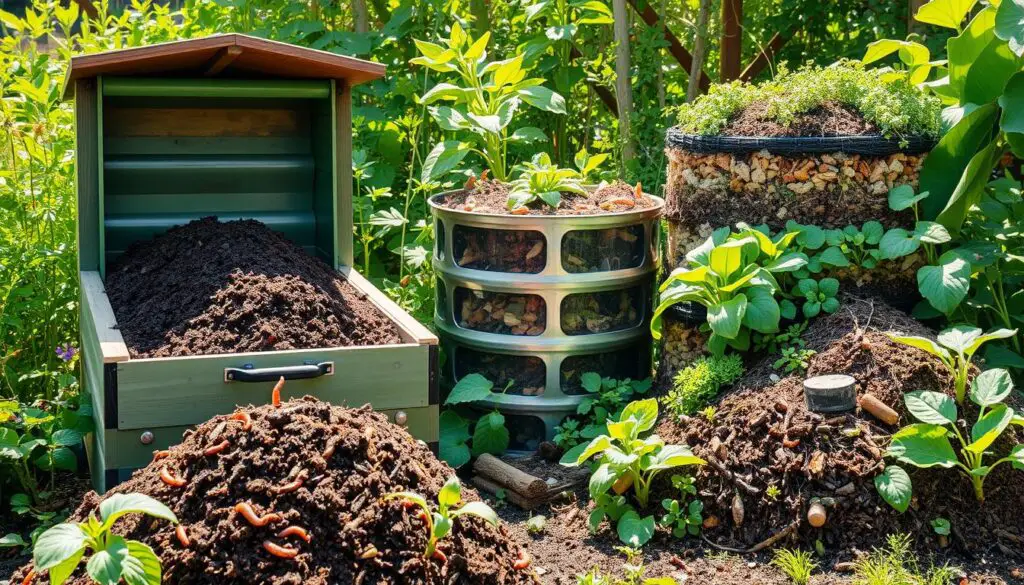
- Fruit scraps
- Vegetable scraps
- Coffee grounds
- Eggshells
- Grass clippings
- Leaves
- Wood chips
- Shredded newspaper
- Sawdust
These items add important nutrients to the compost. But, don’t add meat, dairy, fats, oils, pet waste, or treated wood. They can attract pests and smell bad.
Vermicomposting is another good method. It uses redworms to make compost from waste. This compost makes soil better and supports healthy microbes.
When compost is cool, dry, brown, and crumbly, it’s ready. Using compost in your garden helps plants grow strong. It also supports green gardening.
Water Conservation Strategies
It’s crucial to save water in gardening to keep plants and the environment healthy. Using smart irrigation and mulching can cut down water use. This also boosts garden productivity.
Efficient Irrigation Systems
Choosing the right irrigation systems can save a lot of water. Drip irrigation is a top choice because it waters the soil and roots directly. This cuts down on evaporation.
These systems make sure plants get water when they need it most. Knowing how much water different veggies need helps gardeners use water better. For instance, tomatoes and peppers need steady moisture, while some plants can handle less water.
Mulching to Retain Moisture
Mulching offers many advantages. A 2″ to 3″ layer of mulch keeps the soil moist and can cut water use by half. It also keeps weeds away, so plants get more water.
Keeping the soil moist is key for plants at different stages. This is especially true when they’re young, after being moved, and when they’re flowering or producing fruit. Checking the top 2” of soil helps know when to water. A well-mulched garden needs less watering.
| Water Conservation Strategy | Benefits |
|---|---|
| Drip Irrigation | Reduces evaporation; delivers water directly to roots. |
| Mulching | Retains soil moisture; reduces water needs by up to 50%. |
| Soaker Hoses | Can lower water use by 50%, ideal for garden beds. |
| Rainwater Harvesting | Utilizes collected rainwater for irrigation, conserving resources. |
| Observing Soil Moisture | Signals the right time to water; promotes efficient watering. |
In conclusion, using smart irrigation and mulching is vital for saving water in gardening. By watching water use, gardeners can help the planet and grow healthy plants.
Companion Planting Methods
Companion planting is a cool way to pair plants for better garden health. It uses space well and helps plants grow better. By choosing the right pairs, you can keep pests away, help with pollination, and boost crop growth.
Choosing Beneficial Plant Pairings
Choosing the right plant pairs is key in companion planting. The Three Sisters method, with corn, beans, and squash, is a great example. Each plant helps the others by giving nutrients, shade, and support. Here are some good pairings:
- Basil with tomatoes to improve flavor and repel pests.
- Dill alongside ladybugs, enhancing natural pest control.
- Nasturtiums planted with brassicas to deter aphids.
- Garlic near carrots to repel carrot flies.
- Sunflowers providing support for pole beans.
By using these pairings, you can make your garden more diverse and strong. This helps keep pests away naturally.
Enhancing Biodiversity in Your Garden
Adding companion planting to your garden boosts biodiversity. Different plants together create a balanced ecosystem. This is good for beneficial insects. Here are some ways to do it:
- Use intercropping, like planting peas and carrots together, to fix nitrogen.
- Choose herbs like mint or calendula to attract beneficial insects that fight pests.
- Plant crops in staggered patterns to use space better and help them grow.
Studies show companion planting can almost double what you can grow in a small area. It makes your garden more productive and sustainable.
| Plant Pairing | Benefit |
|---|---|
| Basil + Tomatoes | Flavor enhancement and pest deterrent |
| Dill + Ladybugs | Natural pest control |
| Nasturtiums + Brassicas | Deter aphids |
| Garlic + Carrots | Repel carrot flies |
| Sunflowers + Pole Beans | Structural support |
The Benefits of Heirloom Seeds
Heirloom seeds are key in organic gardening, offering a wealth of seed diversity. These varieties have been loved for over 50 years. They keep alive unique flavors and traits that modern hybrids often miss.
Gardeners who use heirloom seeds grow vegetables that show their heritage. This helps in getting consistent quality and saving seeds for later. It’s a big plus of heirloom varieties.
Heirloom seeds are also more budget-friendly than hybrids. They don’t need lab work or special pollination. This keeps their cost down. With more people gardening, demand for these seeds is rising.
Buying from trusted sources ensures you get high-quality heirloom seeds. This is important for the best results.
Heirloom seeds are open-pollinated, making it easy to save and replant them. This helps gardens become more self-sufficient. It also means you can grow a wide range of colors, sizes, and flavors not found in most stores.
| Aspect | Heirloom Seeds | Hybrid Seeds |
|---|---|---|
| Age Requirement | At least 50 years | Typically newer |
| Seed Saving | True-to-type, easily saved | Not true-to-type, often sterile |
| Flavor Variety | Unique and diverse | Standardized and often bland |
| Adaptability | Higher resilience and adaptability | Less adaptable; designed for uniformity |
| Organic Certification | Often organic, no synthetic chemicals | May not be organic; chemical modifications common |
Using heirloom seeds boosts your garden’s genetic diversity. This makes it more resistant to pests and diseases. It also supports biodiversity, which is crucial for a healthy garden.
From Brandywine tomatoes to Black Seeded Simpson lettuce, there’s a wide range of heirloom seeds to choose from. Each seed has a story, passed down through generations of farmers.
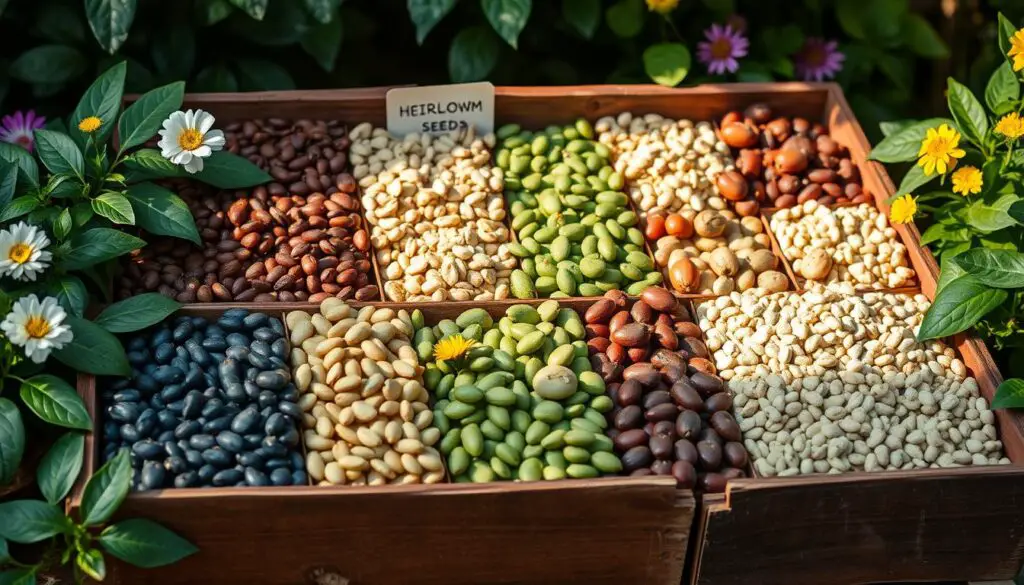
Understanding Biodynamic Farming Principles
Biodynamic farming is a special way of growing food that connects soil, plants, animals, and people. It goes beyond regular organic farming by focusing on regrowth and respecting nature’s cycles. This method sees a farm as a living system, aiming to improve health and diversity.
Worldwide, over 5,000 farms cover more than 400,000 acres under the Demeter Biodynamic Standard. These farms must grow at least 50% of their animal food on-site. They also set aside 10% of their land for wildlife, showing their dedication to the planet and sustainable living.
The six main biodynamic preparations help the soil and its microbes. They use natural stuff like yarrow and dandelion to keep nutrients balanced. Sprays made from animal manure and horsetail tea help plants fight off diseases and grow better.
Since 1924, biodynamic farming has been guided by Rudolf Steiner’s teachings. It views a farm as a community where everything works together. Animals are treated well, and their homes are respected, making sure they help grow healthy food.
Even though biodynamic farming is practiced in over 50 countries, it faces market hurdles. Yet, its popularity is growing, thanks to groups like the Biodynamic Association, started in 1938. This farming style focuses on the environment, social justice, and community, all key to sustainable farming.
| Principle | Description |
|---|---|
| Holistic Approach | Treating the farm as an interconnected organism. |
| Lunar and Cosmic Rhythms | Integrating planting and farming activities with celestial cycles. |
| Biodiversity | Allocating land for diverse plant and animal species. |
| Soil Health | Using preparations to enhance microbial diversity and stability. |
| Animal Welfare | Ensuring humane treatment and natural living conditions for livestock. |
| Social Responsibility | Commitment to environmental and community well-being. |
Implementing Crop Rotation Practices
Crop rotation is key in organic gardening. It boosts soil health improvement and fights common garden problems. By moving plants around each season, gardeners get the most out of this method. Knowing how to rotate plants helps keep the soil rich and prevents pests and diseases.
Improving Soil Health Through Crop Diversity
Using a variety of plants through garden crop diversity renews soil nutrients. Legumes, for example, add nitrogen, making the soil more fertile. Rotating plants like nightshades, legumes, brassicas, and cucurbits over three years or more is beneficial. This not only improves soil but also keeps pests like squash vine borers and cucumber beetles away.
Keeping a garden log or map is important. It helps track where each plant family is, avoiding disease spread. Raised beds make crop rotation easier, especially in small spaces, by simplifying plant management.
The table below shows key plant families for rotation and their nutrient effects:
| Plant Family | Example Crops | Nutrient Contribution/Depletion |
|---|---|---|
| Solanaceae | Tomatoes, Peppers | High potassium demand |
| Cucurbitaceae | Squash, Cucumbers | High nitrogen depletion |
| Brassicaceae | Broccoli, Cabbage | Moderate nutrient demand |
| Fabaceae | Beans, Peas | Nitrogen-fixation |
| Alliaceae | Onions, Garlic | Utilizes potassium |
| Apiaceae | Carrots, Parsnips | Variable nutrient requirements |
Effective crop rotation needs dedication and knowledge of your garden. It increases yields and soil health. Crop rotation keeps your garden lively and productive year after year. For more tips, check out this resource.
Organic Fertilizers for Optimal Growth
Organic fertilizers are key for healthy plants. Knowing the types helps gardeners choose the best for their plants. Sea-Crop is a favorite for its wide range of nutrients.
Liquid fertilizers like kelp and fish emulsion give plants the nutrients they need. Studies show that giving plants nutrients regularly is better than giving them a lot all at once. This approach helps plants grow better.
Using organic fertilizers wisely can make a garden more productive. For example, sea minerals can be applied to keep nutrients flowing all year. Adding compost and mulches to the soil helps too. It also helps to introduce microbes to the soil.
Macronutrients like N-P-K are crucial for plant health. Without them, plants can show signs of trouble. Nitrogen helps leaves stay green, phosphorus keeps plants healthy, and potassium boosts fruit quality.
When picking organic fertilizers, always check the labels. Look for “OMRI Listed” to ensure it’s safe for organic gardens. A balanced N-P-K ratio is best, along with other nutrients like calcium and magnesium.
Buying organic fertilizers from local stores is a good idea. It ensures you get quality products. Make sure to buy the right amount for your garden. Timing your fertilizing right can also help plants grow better.
| Fertilizer Type | N-P-K Ratio | Benefits |
|---|---|---|
| Sea-Crop Liquid Fertilizer | 3-1-1 | Improves nutrient diversity |
| Kelp Fertilizer | 1-0-5 | Enhances root growth and stress resistance |
| Fish Emulsion | 5-2-2 | Rich in nitrogen for lush foliage |
| Happy Frog Tomato & Vegetable Fertilizer | 5-4-4 | Balanced nutrition for fruits and vegetables |
Using organic fertilizers makes gardens more productive and sustainable. It keeps the soil healthy for years.
Organic Gardening Tips for Beginners
Starting an organic garden can be very rewarding. It helps you connect more with nature. For beginners, it’s key to start with some basic steps for success.
Healthy roots are crucial for a garden. So, making nutrient-rich soil is a must. Adding compost helps keep the soil fertile.
Many new gardeners forget to test their soil. Knowing the soil’s pH and nutrient levels helps you make the right changes. This supports your plants’ growth.
Getting enough sunlight is vital for plants. Utah State University Extension says plants need at least 7 hours of sunlight a day. Knowing when the sun hits your garden helps prevent pests and diseases.
Managing water is also important. A drip irrigation system is great, especially in dry summers. It waters the roots directly, saving water and promoting deeper roots. Watering in the morning helps plants use the water better and reduces disease risk.
Using companion planting is another smart move. It helps keep pests away and attracts good insects. For example, carrots and onions together can keep onion flies away. Basil near tomatoes attracts bees, helping tomatoes grow better.
Choosing the right tools is also crucial. You’ll need a shovel, rake, broadfork, and watering can. These tools make gardening easier and more fun.
| Aspect | Tip |
|---|---|
| Soil Preparation | Add compost to enrich soil nutrient content. |
| Sunlight | Ensure at least 7 hours of sunlight for plants. |
| Watering | Employ drip irrigation for efficient moisture delivery. |
| Companion Planting | Pair plants to naturally deter pests and attract pollinators. |
| Tools | Use essential tools like shovels and watering cans for ease of gardening. |
By following these tips, beginners can grow a thriving organic garden. It’s not just good for you but also for the local ecosystem. Organic gardening is a journey of growth, learning, and joy.
Conclusion
Organic gardening is a rewarding way to create a healthy environment. It meets the growing demand for healthier food. By following the tips in this article, beginners can make their gardening better and improve their food’s quality.
These practices are good for you and the planet. They help keep chemicals out of our water and support more life in nature.
Important organic gardening tips include knowing about soil health and choosing the right plants. Using organic materials helps plants grow well. Composting, rotating crops, and managing pests are key to keeping soil and plants healthy.
These tips remind us that our gardens are connected to the world around us. They show how our gardening affects the environment.
We encourage you to try these organic gardening methods. Remember, learning is a journey. For more tips and inspiration, check out Svetb.com.
Their experts offer practical advice. They help you enjoy gardening and make it a rewarding activity.
FAQ
What is organic gardening?
Organic gardening uses natural solutions for soil care and pest control. It avoids synthetic chemicals. This method helps plants and soil stay healthy.
What are the benefits of organic gardening?
Organic gardening improves soil health and supports wildlife. It makes produce more nutritious. It can also save money and support sustainable farming.
How can I improve soil fertility naturally?
Start by testing your soil to know what it needs. Then, add organic materials like compost and manure. Crop rotation and cover cropping also help.
What are effective methods for natural pest control?
Use companion planting and beneficial insects to control pests. Natural repellents are also helpful. Keeping an eye out for pests keeps your garden healthy.
What should I know about composting?
Composting enriches soil health. Use green and brown materials and keep it moist. Regularly turning the pile is key. Vermicomposting speeds up the process.
How can I conserve water while gardening?
Use drip irrigation and mulch to save water. These methods help plants grow better with less water.
What is companion planting?
Companion planting pairs plants to improve growth and pest control. Some combinations deter pests, attract beneficial insects, and boost yields.
Why are heirloom seeds important?
Heirloom seeds are open-pollinated and diverse. They offer unique flavors and are resilient against pests. They also support traditional farming.
What are the principles of biodynamic farming?
Biodynamic farming views the farm as a whole organism. It uses organic methods and lunar cycles for planting. This improves soil health and supports sustainability.
How does crop rotation benefit my garden?
Crop rotation prevents pests and improves soil fertility. It also increases nutrient diversity. Rotating crops based on families optimizes soil health and biodiversity.
What types of organic fertilizers are available?
There are dry fertilizers like blood meal and liquid options. Each provides essential nutrients for plant growth when used correctly.
What are some beginner organic gardening tips?
Beginners should learn about soil health and plant selection. Manage pests naturally and start with simple tasks. Learning sustainable practices helps create a successful garden.

